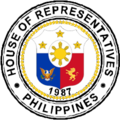House of Representatives of the Philippines
From Worldatplay
(O0zo12 I truly appreciate this blog post.Really thank you! Much obliged.) |
|||
| Line 4: | Line 4: | ||
The official headquarters of the House of Representatives is at the ''Batasang Pambansa'' (literally, national legislature) located at the Constitution Hill in Quezon City in Metro Manila. The building is often simply called Batasan. | The official headquarters of the House of Representatives is at the ''Batasang Pambansa'' (literally, national legislature) located at the Constitution Hill in Quezon City in Metro Manila. The building is often simply called Batasan. | ||
| - | + | O0zo12 I truly appreciate this blog post.Really thank you! Much obliged. | |
| - | + | ||
| - | + | ||
| - | + | ||
| - | + | ||
| - | + | ||
| - | + | ||
| - | + | ||
==District representation== | ==District representation== | ||
Revision as of 11:48, 8 March 2012
The House of Representatives of the Philippines (Filipino: Kapulungan ng mga Kinatawan ng Pilipinas) is the lower chamber of the Congress of the Philippines. The Senate is the upper chamber. The House is often informally called the Congress. Members of the house are called Congressmen (mga kinatawan or mga konggresista) and their title is Representative. Congressmen are elected to a three-year term, and can be reelected to a maximum of consecutive three terms. A congressman may be a district representative, which represents a particular geographical area. There are 212 legislative districts in the country, each composed of about 250,000 people. In addition, there are Sectoral Representatives elected through the party-list system who constitute not more than twenty percent of the total number of Representatives.
The official headquarters of the House of Representatives is at the Batasang Pambansa (literally, national legislature) located at the Constitution Hill in Quezon City in Metro Manila. The building is often simply called Batasan.
O0zo12 I truly appreciate this blog post.Really thank you! Much obliged.
Contents |
District representation
All provinces and several cities have at least one congressional/legislative district, whose residents vote for their own congressman. Each district covers a population of approximately 250,000 to 500,000 people. Provinces that have only one congressional/legislative district are divided into two provincial districts for the purpose of electing Sangguniang Panlalawigan (Provincial Council) members. For provinces that have more than one congressional/legislative district, the provincial districts are identical to the corresponding congressional/legislative district.
Congressional/legislative districts in provinces
|
|
|
Congressional/legislative districts in cities
|
|
|
Sectoral representation
The party-list system is the name designated for the sectoral representation. Under the Constitution, the electorate can vote for certain party-list organizations in order to give voice to significant minorities of society that would otherwise not be adequately represented through geographical district. From 1987-1998, sectoral representatives were appointed by the President.
Since 1998, each voter votes for a single party-list organization. Organizations that garner at least 2% of the total number of votes are awarded one representative for every 2% up to a maximum of three representatives. Thus, there can be at most 50 sectoral representatives in Congress, though usually no more than 20 are elected because many organizations do not reach the required 2% minimum number of votes.

